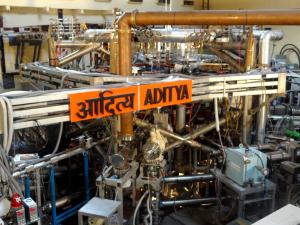India’s contributions to ITER
The visit of Prime Minister Narendra Modi last week brought attention to the vital contributions that India is making to the ITER project, both in terms of industrial expertise and skilled personnel.
From early contributions to the field of mathematics—India gave us the number zero and the modern decimal system, for example—to the first conceptualization of the atom … from the invention of chess 1,400 years ago to the first spacecraft to land in the Moon’s south polar region … India has a long and distinguished record in maths, science and engineering.
When it joined other nations with fusion programs as part of the ITER project in 2005, it had been operating its first tokamak, Aditya, for six years at the Institute for Plasma Research (IPR). Aditya—now upgraded to Aditya-U—routinely conducts experimentation in support of ITER operation.
India’s domestic fusion program lay the foundation for its participation in ITER and, in turn, participation in ITER over the past 20 years has helped India to advance its expertise in fusion science and technology, as well as in a variety of engineering disciplines, and to train a skilled workforce—all important constitutive elements for a domestic nuclear fusion industry that is capable of supporting nuclear fusion power plants in the future.
Major Indian companies—Larsen & Toubro (L&T), Inox India, Tata Consultancy Services, Tata Consulting Engineers, HCL Technologies and others—are supplying ITER components and systems through contracts signed with the Indian Domestic Agency. The cryostat, in-wall shielding for the ITER vacuum vessel, significant contributions to cooling water and cryogenic systems, the diagnostic neutral beam and diagnostics are all part of these in-kind deliveries to the project. Increasingly, Indian companies are also winning direct contracts with the ITER Organization for critical machine assembly activities. Last year Larsen & Toubro, for example, was awarded a contract for port positioning alignment and welding—a scope that includes engineering, qualification and tools, and in-pit welding of vacuum vessel ports and bellows.
India also makes a significant contribution to the human resources behind the implementation of the ITER project. Some 200 people—staff and ITER Project Associates—are currently working on site, and many more have been trained at ITER over the years through 3- to 5-year assignments.
During a previous visit to France in 2019, Prime Minister Modi spoke of signature projects in atomic energy, aerospace and tech that link his country with France, and included ITER in the list. “The only fusion project under construction in the world is in France and India is part of it. A highly capable Indian team is involved in this major scientific venture, one of the most important of this century. When fusion technology becomes available, providing immense quantities of energy for future generations, this achievement will bear the mark of your contribution. Think of the pride that will be felt by every Indian!”
On 12 February, Prime Minister Modi was able to address the team members in person, encouraging them in their work and thanking them for their dedication.
India news outlets ANI, Radio India and DD News were on site to cover the Prime Minister’s historic visit, which was widely reported across India. When asked in an interview with DD News about the value of India’s input into ITER, Director-General Pietro Barabaschi had the following comment. “What I see from India is a lot of valuable contributions in terms of new ideas. I am very happy with Indian suppliers so far—they are serious and reliable—and such companies will continue to remain engaged and work with us closely because this work of assembly requires not only the workforce but also the ingenuity and the organization of existing large industrial suppliers like the ones you have in India.”
India, like other ITER members, is exploring concepts for a demonstration reactor, DEMO, that will test technologies for a fusion reactor. India’s participation in ITER, said the head of the Office of the ITER Director-General KR Sriram to DD News “will help lay the foundation for how the Indian nuclear fusion industry, both private and public, could be foreseen in the future.”
Watch the "DD News" interview here.
See photos of Prime Minister Modi’s visit to ITER here.



